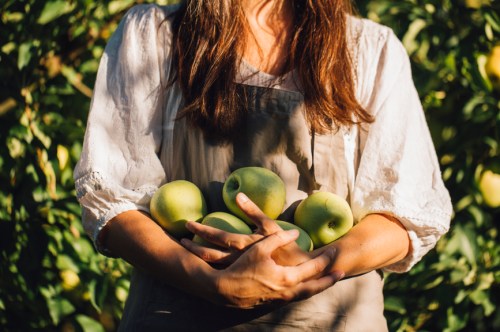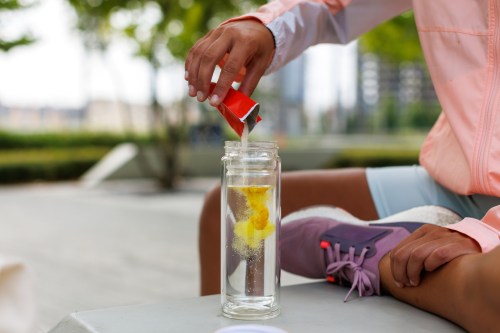Our editors independently select these products. Making a purchase through our links may earn Well+Good a commission
It’s Officially Fall, Which Means You’re More Likely To Be Deficient in These 6 Essential Nutrients—Here’s How To Deal
An RD shares the key nutrients for fall that we're more likely to be deficient in during colder months, plus which foods are rich in each.

With the change in seasons comes a shift in many of our day-to-day routines: Our skincare rituals pivot to prioritize moisture, outdoor workouts start moving inside, every outfit gets built around the base of a scarf and cozy sweater, and (most importantly) our recipe rotation goes through a serious makeover. It’s out with the ice cream and in with the hearty soups!
Experts in This Article
registered dietitian and author of Smoothies &
But the arrival of cold weather isn’t all about curation: There are a few essential nutrients we’re naturally more likely to be deficient in during fall and winter months that we should be mindful of. Same goes for the importance of bolstering your immune system, boosting your bone health, and keeping your mood up as temps drop and sunny days fade.
Ready to feel energized, healthy, and (hopefully) up your chances of avoiding at least one bout of the common cold this year? Read on for nutrients to prioritize in the fall and winter, plus which foods are the top sources of each.
Here’s a look at six essential nutrients that RDs recommend prioritizing in your meals in the fall and winter months
Vitamin D
“Vitamin D is critical for immunity, brain health, bone health, and reduced risk of cancer, type 2 diabetes, and heart disease,” says Frances Largeman-Roth, RDN, nutrition expert and author of Smoothies & Juices: Prevention Healing Kitchen. According to Largeman-Roth, in the warm months when there is plenty of sun, our bodies can produce vitamin D when the sun hits our skin—but when the weather gets colder, we need to put an increased focus on food sources.
“Wild seafood, especially salmon, is one of the most significant food sources of vitamin D. In fact, a four-ounce serving of cooked or canned wild Alaska sockeye salmon provides more than 100 percent of your daily vitamin D needs (600 IU/15 mcg),” says Largeman-Roth. Another easy way to get more vitamin D into your day is with fortified OJ. “It supplies 2.5 mcg per eight-ounce glass. You can drink it on its own or add it to smoothies. Many cereals, including kid faves like Wheaties and Rice Krispies, are also fortified with between 10-15 percent of the daily vitamin D requirement.” That being said, deficiency is common, so be sure to consult a healthcare professional if you think you may need a vitamin D supplement.
Calcium
While we need calcium year-round, what changes in the cold weather is the risk of falling and fracturing a bone. “While weak bones may go unnoticed during the warm months, those vulnerabilities get exposed when a fall happens, whether we’re 40 or 80,” says Largeman-Roth. “All adults ages 19 to 50 need 1000 mg of calcium daily. After age 50, the need for women goes up to 1200, while it remains the same for men.”
Unfortunately, it’s challenging to get enough calcium because the requirement is so high. Also because you need vitamin D for optimal calcium absorption: If you’re not getting enough of either nutrient, this doesn’t bode well for your bones. Largeman-Roth singles out milk, yogurt, cheese, and dark leafy greens like kale, broccoli and bok choy as great sources of calcium. “A cup of raw kale contributes 52 mg of calcium, one cup of cooked broccoli has 62 mg, one cup cooked bok choy provides 158 mg, and a cup of cooked acorn squash offers 90 mg,” she says.
Zinc
This mineral is a crown jewel for the immune system. “Without zinc, kids don’t grow normally, wounds don’t heal, and our sense of taste and smell are affected,” says Largeman-Roth. “Men need 18 mg of zinc per day, while women only need 8 mg, though needs increase with pregnancy and breastfeeding.”
You’ll find zinc in red meat, shrimp, seeds, and beans. “A one-ounce serving of pumpkin seeds provides 2.2 mg of zinc and an ounce of cheddar cheese serves up 1.5 mg of zinc, but the very best source are oysters, with a whopping 32 mg of zinc in three briny ounces,” Largeman-Roth says.
Iron
Iron deficiency is very common in the United States: 10 million people falling into the deficient category, and five million actually have iron deficiency anemia,” shares Largeman-Roth. Unfortunately, iron deficiency makes an individual more susceptible to getting sick.
“Men ages 19 to 50 require 8 mg per day, while women need a significantly higher amount of 18 mg per day. Iron can come from both heme—meaning animal-based sources—and non-heme, which are plant sources. Either way, you’ll want to include a vitamin C-rich food when you’re eating iron-rich foods to help with absorption,” says Largeman-Roth.
While meat is an obvious source of iron, chickpeas are a tasty plant-based way to include more iron (as well as protein and fiber) in your diet. “The latest USDA Dietary Guidelines recommend including chickpeas, beans, and lentils in our meals one to three times per week, but about 80 percent of us aren’t doing that,” says Largeman-Roth. “In addition to adding iron-rich chickpeas to salads and grain dishes and making hummus, you can also incorporate chickpea pasta in your weekly meals. A 3.5-ounce serving of Banza chickpea pasta provides 30 percent of the daily iron requirement. Top it with marinara sauce for a source of vitamin C to help absorb the mineral.”
Another great vegetarian source of iron is whole grain oats. “One half-cup serving provides of oats has 2 mg of iron, which makes it a good source. I like using Bob’s Red Mill Rolled Oats for oatmeal and overnight oats. In addition to the iron, rolled oats also contain heart-healthy soluble fiber, which may help reduce the risk of heart disease as part of a diet low in saturated fat and cholesterol,” adds says Largeman-Roth.
Vitamin C
It comes as little surprise that this antioxidant vitamin is essential for staying well. “Vitamin C is important for the general health of our skin, wound healing, fighting inflammation, and for staving off infections. If you’re healing from a wound or operation, it’s smart to boost your vitamin C intake,” says Largeman-Roth.
According to Largeman-Roth, the requirement for vitamin C (90 mg for men and 75 mg for women) doesn’t change throughout the year, but the way we eat it does. Vitamin C breaks down under heat and light. “In the summer we eat many vitamin C-rich fruits and veggies raw, but when the temps turn cold we begin to roast, bake, and pressure-cook vegetables, which reduces the available amount of vitamin C. That means we need to put a bigger focus on eating more vitamin C-rich foods, like citrus fruits, broccoli, tomato-based dishes, potatoes, bell peppers, and kiwi. You can either eat the item raw or cook it briefly, like stir frying or blanching—broccoli in particular tastes great that way.”
Need more inspiration? One kiwi provides 69 mg of vitamin C, a cup of cooked broccoli has 33 mg, and an eight-ounce glass of orange juice boasts over 100 percent of the daily requirement.
B vitamins (B6, B12)
B vitamins as a group are critical as they’re involved in processing food to release energy, brain health and cell metabolism. “Rice, eggs, and black beans all provide B vitamins,” says Largeman-Roth. “While we may not need more in the colder months, we certainly can feel the effects of not getting enough, such as fatigue, even more during the fall and winter.” This is because vitamin B is closely connected to your mood and energy levels.
Vitamin B6 (pyridoxine) is particularly important as it’s helpful for normal brain function and is involved in the breakdown of carbohydrates, protein, and fat, as well as keeping your immune system running. “The daily requirement for vitamin B is 1.3 mg for men and 1.2 mg for women, and it’s found in tuna, salmon, fortified cereal, potatoes, chickpeas, poultry, beef liver, and bananas,” says Largeman-Roth. “One cup of fortified cereal, like Total, provides 100 percent of the daily requirement for B6. A medium banana serves up 20 percent of the requirement. And for a crunchy on-the-go snack, grab some Gold Emblem Abound Sea Salt Roasted Chickpeas, which offer 1.1 mg of B6 in a cup. They’re a super portable and affordable snack.”
B12 is another one of the key nutrients for fall worth highlighting, as it keeps our nerve cells and red blood cells healthy. According to Largeman-Roth, we need 2.4 mcg daily. “Vegans may struggle to get enough vitamin B12 because it’s primarily found in meat and dairy products, but you can get 0.2 mcg in an eight-ounce glass of fortified oat milk and nutritional yeast packs a B12 punch with 630 percent of the daily requirement in just two tablespoons,” says Largeman-Roth. “Sprinkle it over popcorn or pasta for a cheesy-tasting topper. Finally, because it’s fermented, tempeh contains 0.1 mg of B12 per one cup serving.”










